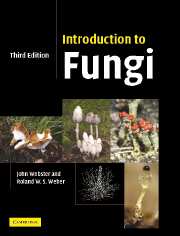Book contents
- Frontmatter
- Contents
- Preface to the first edition
- Preface to the second edition
- Preface to the third edition
- Acknowledgements
- 1 Introduction
- 2 Protozoa: Myxomycota (slime moulds)
- 3 Protozoa: Plasmodiophoromycota
- 4 Straminipila: minor fungal phyla
- 5 Straminipila: Oomycota
- 6 Chytridiomycota
- 7 Zygomycota
- 8 Ascomycota (ascomycetes)
- 9 Archiascomycetes
- 10 Hemiascomycetes
- 11 Plectomycetes
- 12 Hymenoascomycetes: Pyrenomycetes
- 13 Hymenoascomycetes: Erysiphales
- 14 Hymenoascomycetes: Pezizales (operculate discomycetes)
- 15 Hymenoascomycetes: Helotiales (inoperculate discomycetes)
- 16 Lichenized fungi (chiefly Hymenoascomycetes: Lecanorales)
- 17 Loculoascomycetes
- 18 Basidiomycota
- 19 Homobasidiomycetes
- 20 Homobasidiomycetes: gasteromycetes
- 21 Heterobasidiomycetes
- 22 Urediniomycetes: Uredinales (rust fungi)
- 23 Ustilaginomycetes: smut fungi and their allies
- 24 Basidiomycete yeasts
- 25 Anamorphic fungi (nematophagous and aquatic forms)
- References
- Index
- Plate section
11 - Plectomycetes
- Frontmatter
- Contents
- Preface to the first edition
- Preface to the second edition
- Preface to the third edition
- Acknowledgements
- 1 Introduction
- 2 Protozoa: Myxomycota (slime moulds)
- 3 Protozoa: Plasmodiophoromycota
- 4 Straminipila: minor fungal phyla
- 5 Straminipila: Oomycota
- 6 Chytridiomycota
- 7 Zygomycota
- 8 Ascomycota (ascomycetes)
- 9 Archiascomycetes
- 10 Hemiascomycetes
- 11 Plectomycetes
- 12 Hymenoascomycetes: Pyrenomycetes
- 13 Hymenoascomycetes: Erysiphales
- 14 Hymenoascomycetes: Pezizales (operculate discomycetes)
- 15 Hymenoascomycetes: Helotiales (inoperculate discomycetes)
- 16 Lichenized fungi (chiefly Hymenoascomycetes: Lecanorales)
- 17 Loculoascomycetes
- 18 Basidiomycota
- 19 Homobasidiomycetes
- 20 Homobasidiomycetes: gasteromycetes
- 21 Heterobasidiomycetes
- 22 Urediniomycetes: Uredinales (rust fungi)
- 23 Ustilaginomycetes: smut fungi and their allies
- 24 Basidiomycete yeasts
- 25 Anamorphic fungi (nematophagous and aquatic forms)
- References
- Index
- Plate section
Summary
Introduction
The class Plectomycetes originally contained all ascomycetes which produce their asci within a cleistothecium, i.e. a ‘closed case’. DNA sequence comparisons have revealed that this character was a fairly good one because, with the major exception of the powdery mildews (Erysiphales; see Chapter 13) and few scattered examples in the Pyrenomycetes (Chapter 12) and Helotiales (Chapter 15), most cleistothecium-forming fungi and the anamorphs associated with them have been found to be monophyletic (Berbee & Taylor, 1992a; Geiser & LoBuglio, 2001). As they stand now, the Plectomycetes can be defined by the following set of characters (Alexopoulos et al., 1996; Geiser & LoBuglio, 2001).
(1) A cleistothecium or gymnothecium is usually present; a cleistothecium proper has a thick and continuous (pseudoparenchymatous) wall, whereas in the gymnothecium the wall consists of an open cage-like construction of hyphae, the reticuloperidium (Greif & Currah, 2003). Naked asci are produced only in rare cases.
(2) Ascogenous hyphae are usually not conspicuous.
(3) Asci are scattered throughout the cleistothecium, not produced by a fertile layer (hymenium).
(4) Asci are mostly globose and thin-walled, and the ascospores are released passively after disintegration of the ascus wall, not by active discharge.
(5) Ascospores are small, unicellular and usually spherical or ovoid.
(6) Conidia are commonly produced from phialides (in Eurotiales) or as arthroconidia, which are typically formed as chains of conidia alternating with sterile cells. An arthroconidium becomes released when the neighbouring cells disintegrate. This rhexolytic secession is typical of the microconidia of Onygenales and Ascosphaerales.
- Type
- Chapter
- Information
- Introduction to Fungi , pp. 285 - 314Publisher: Cambridge University PressPrint publication year: 2007



